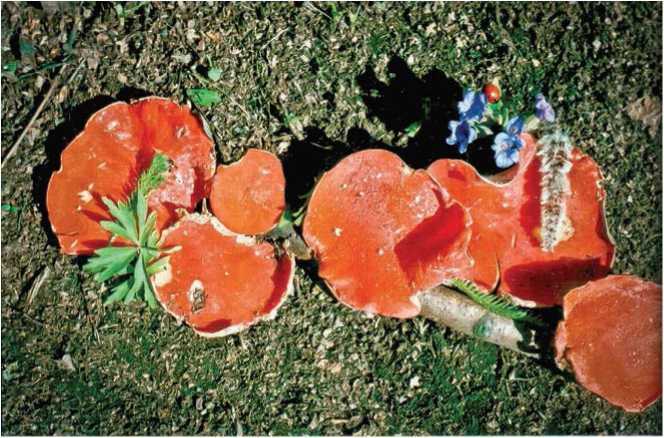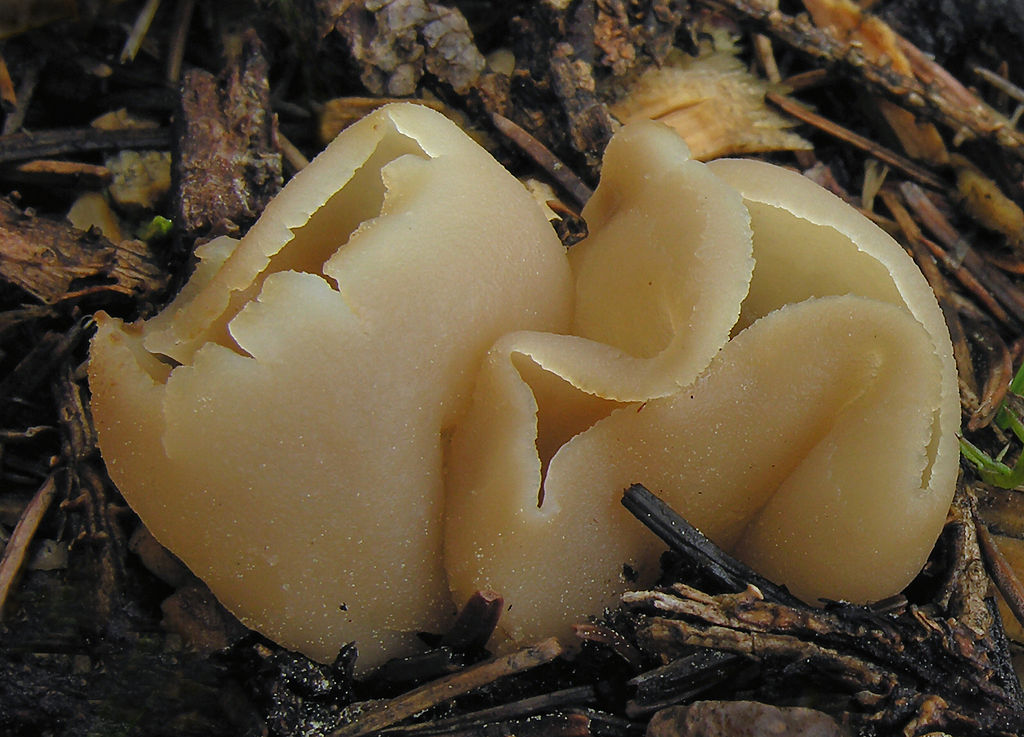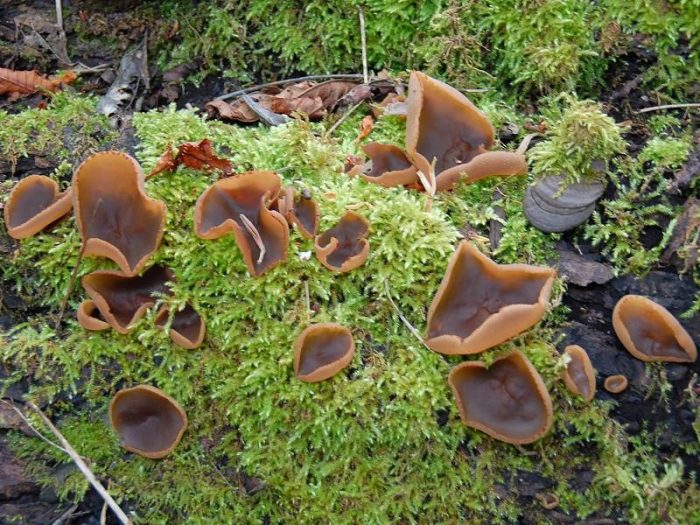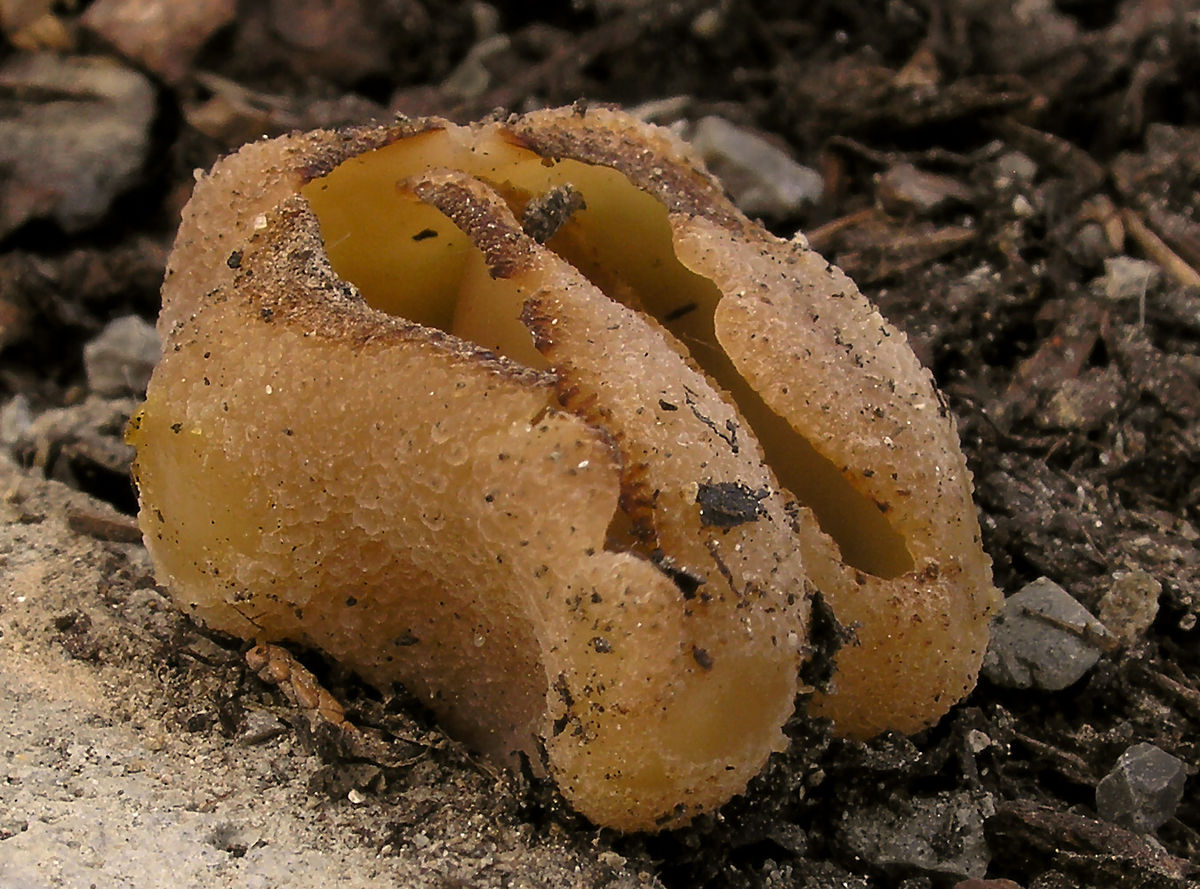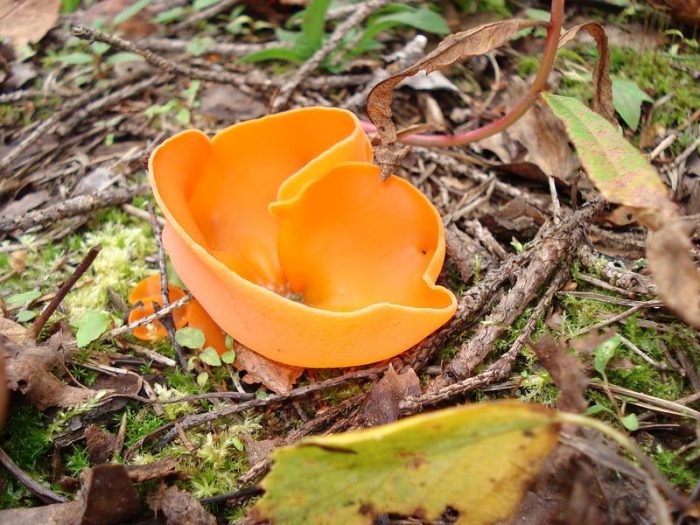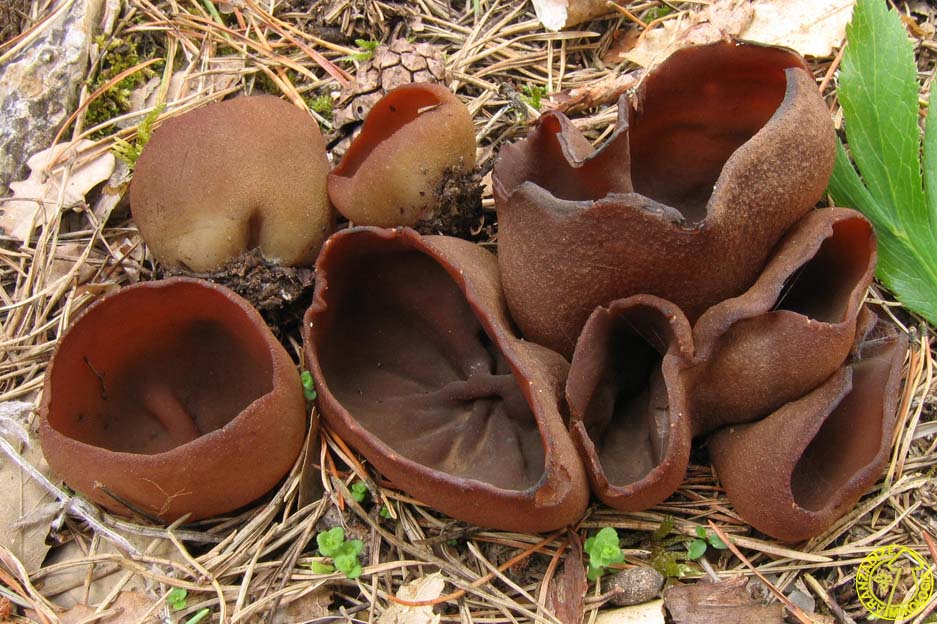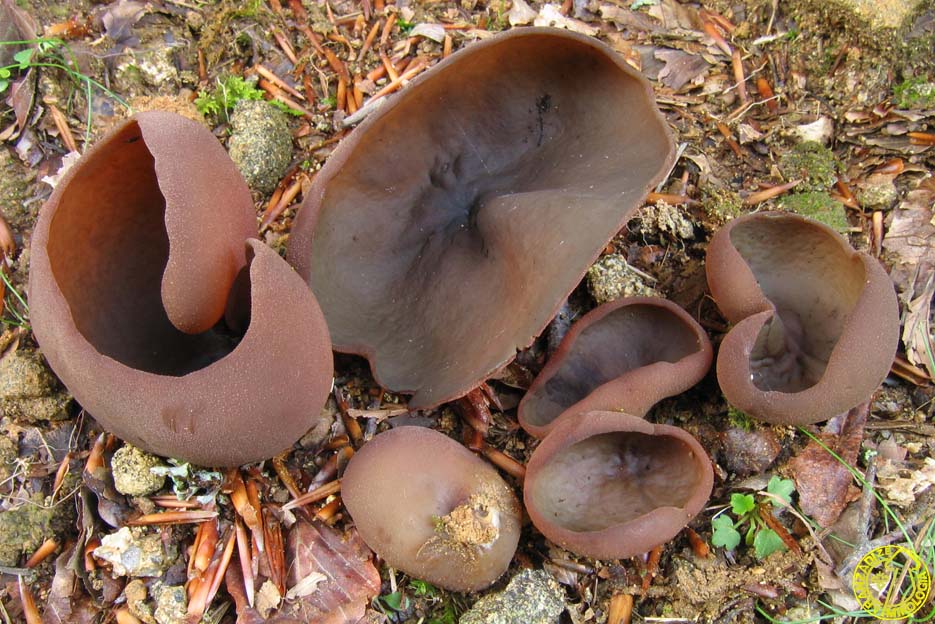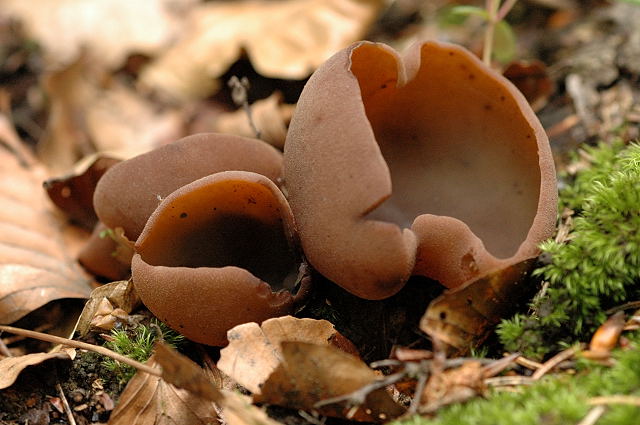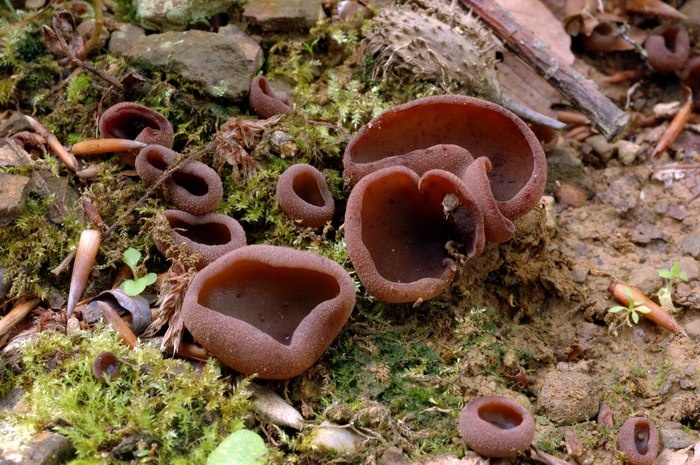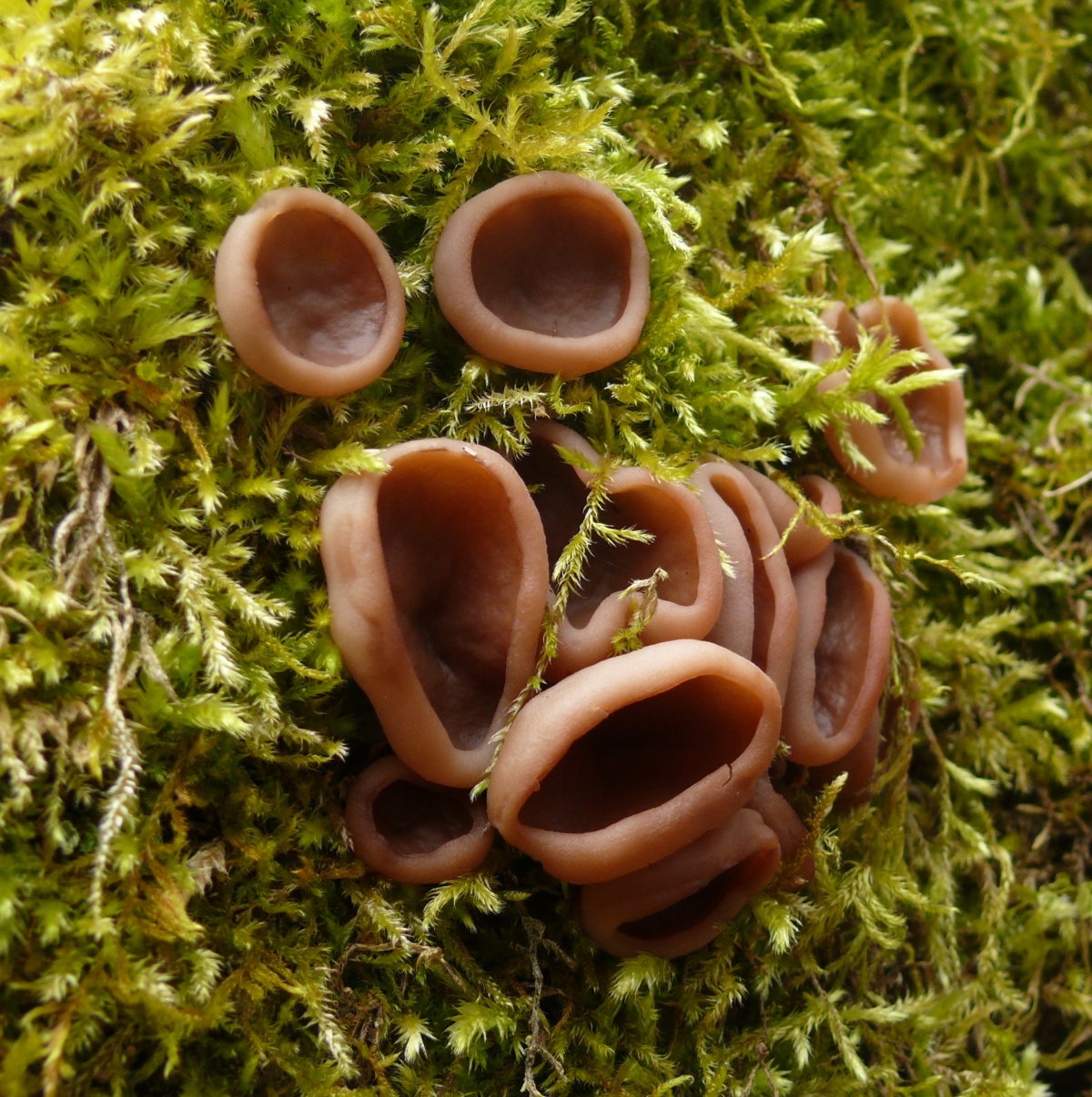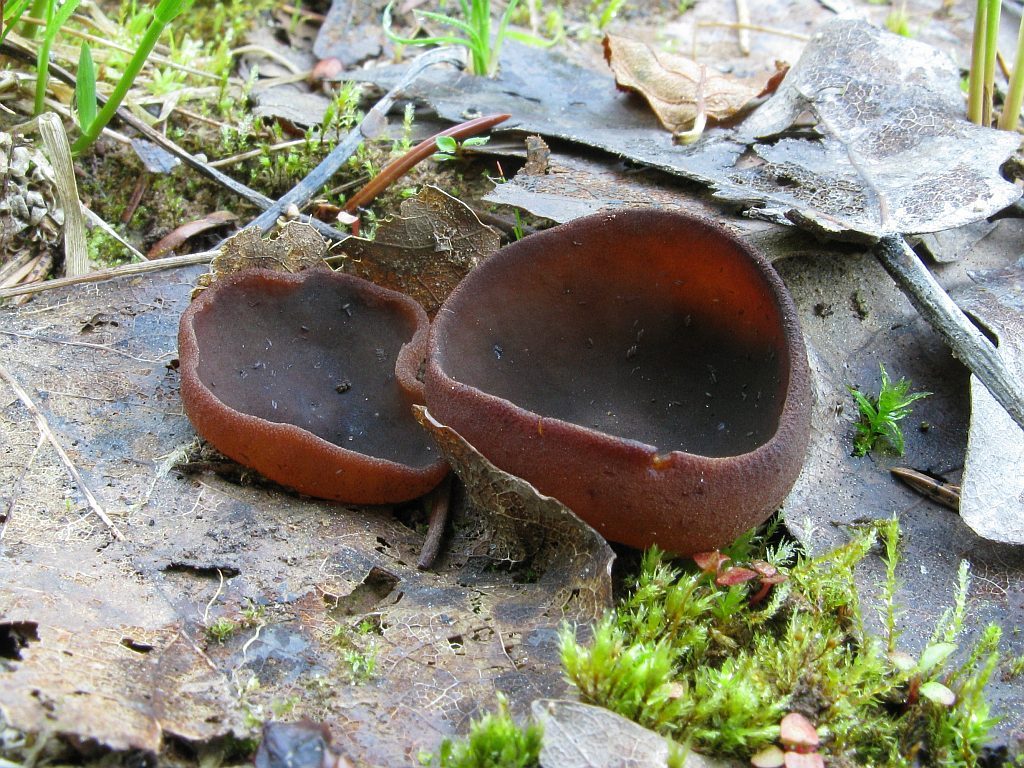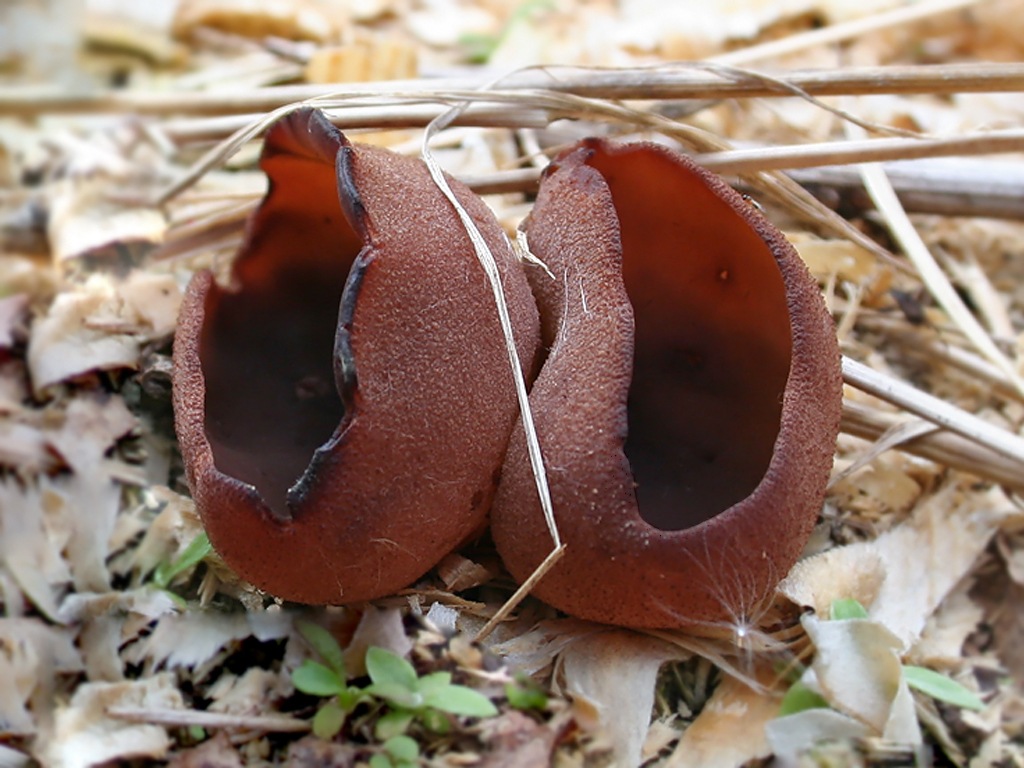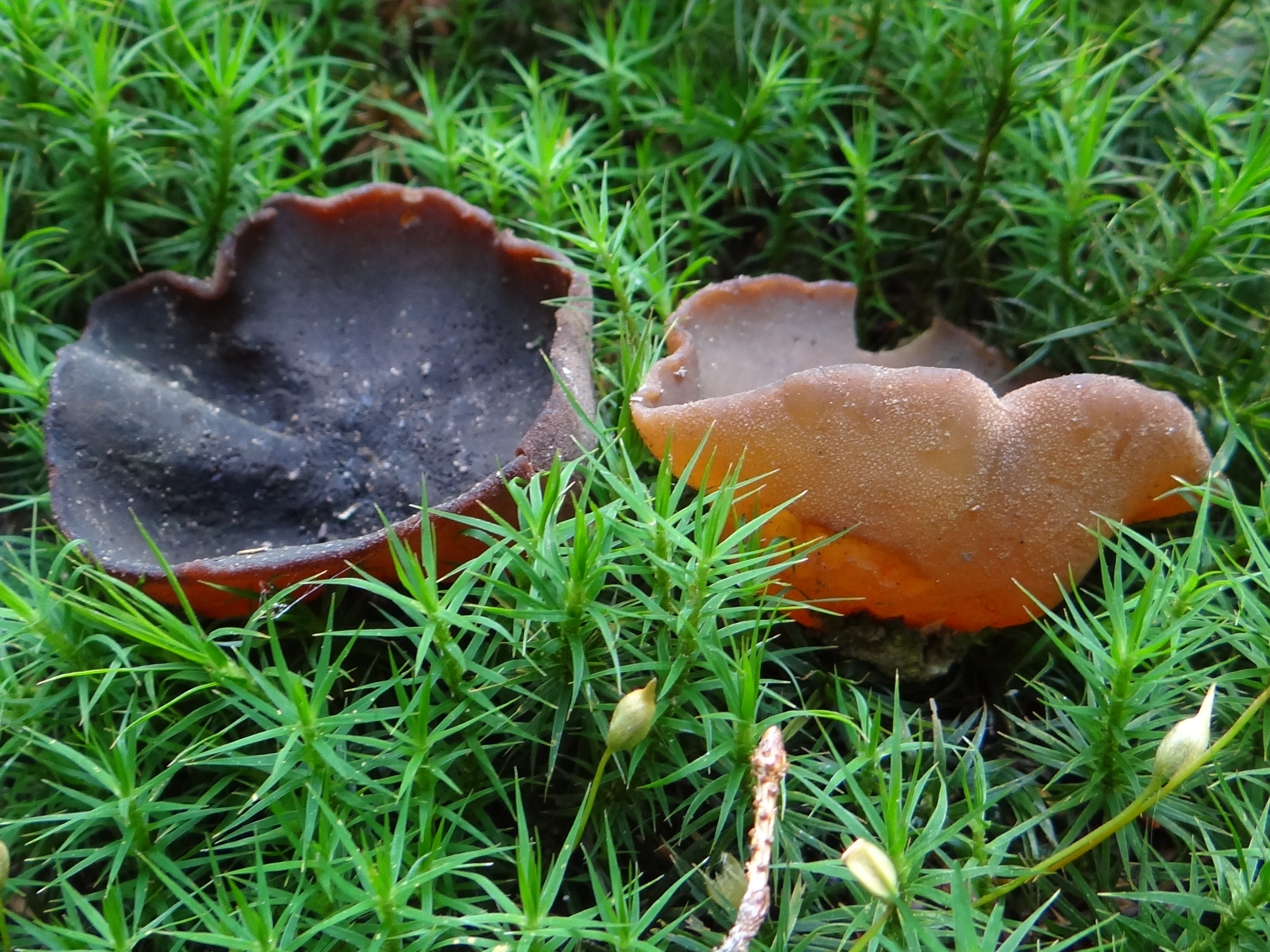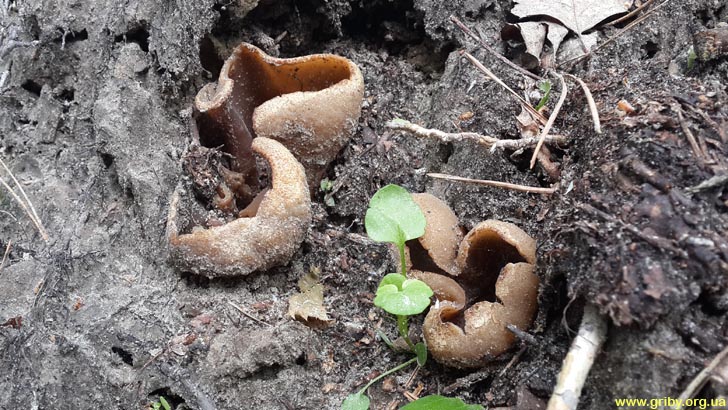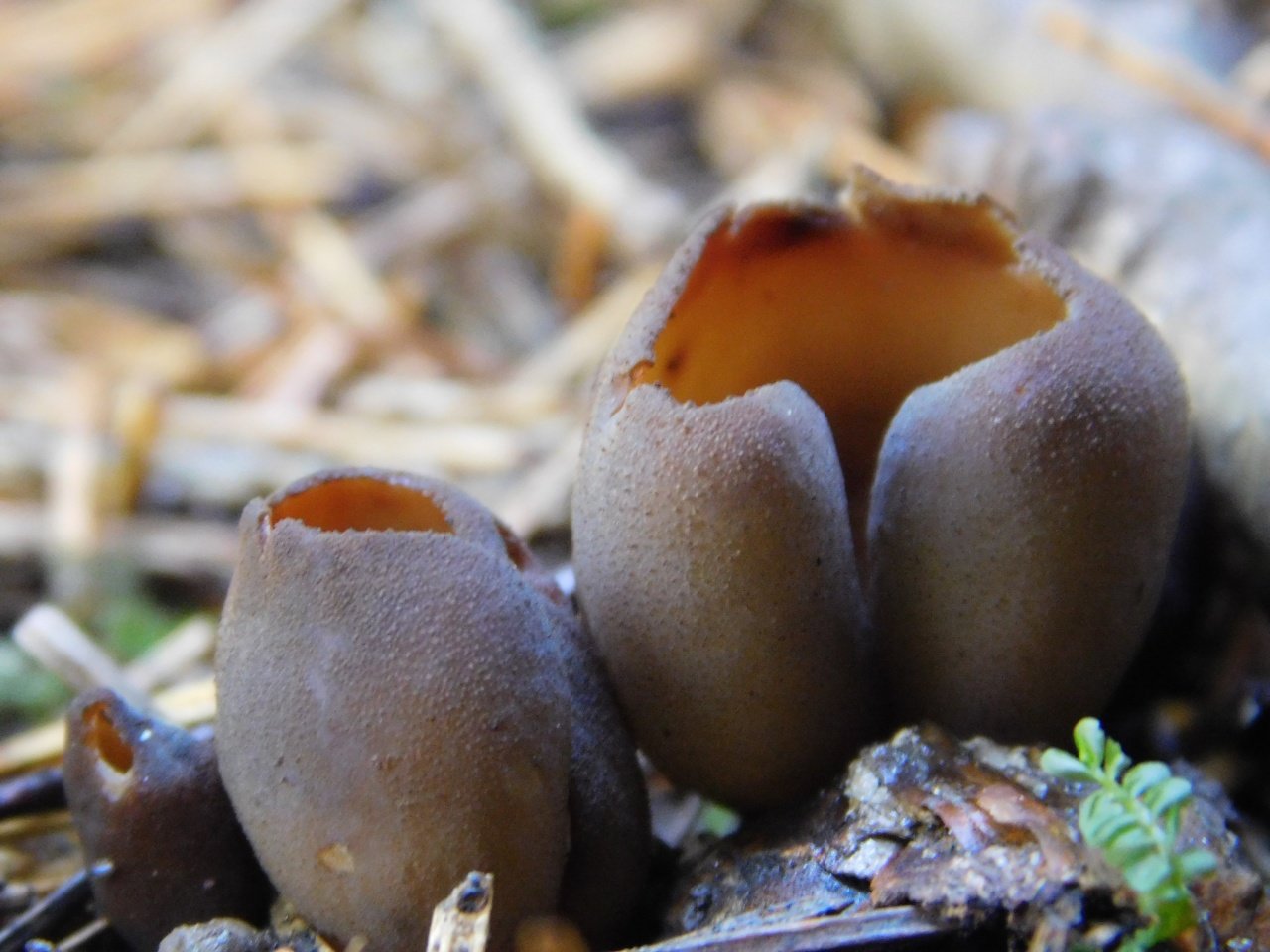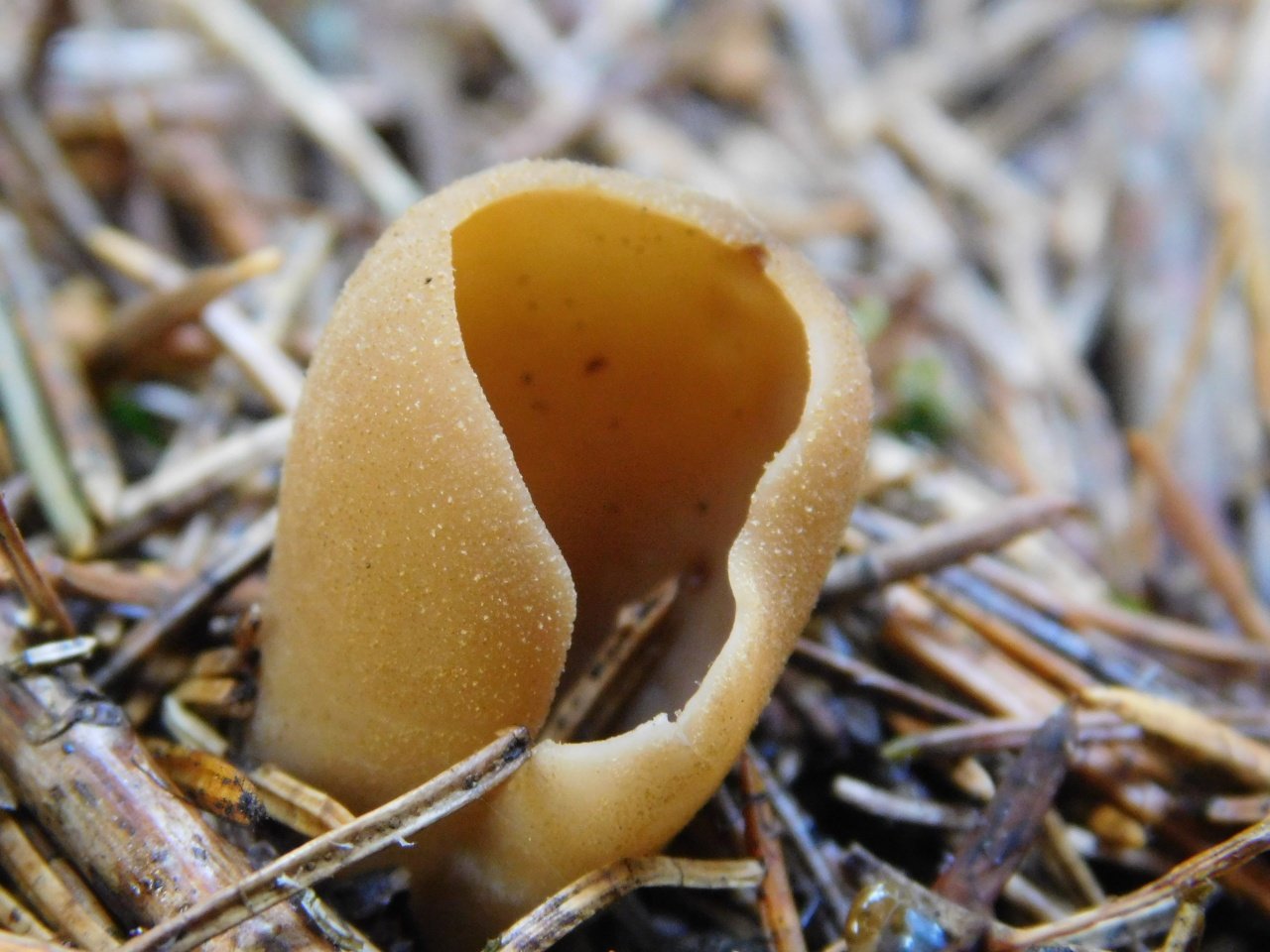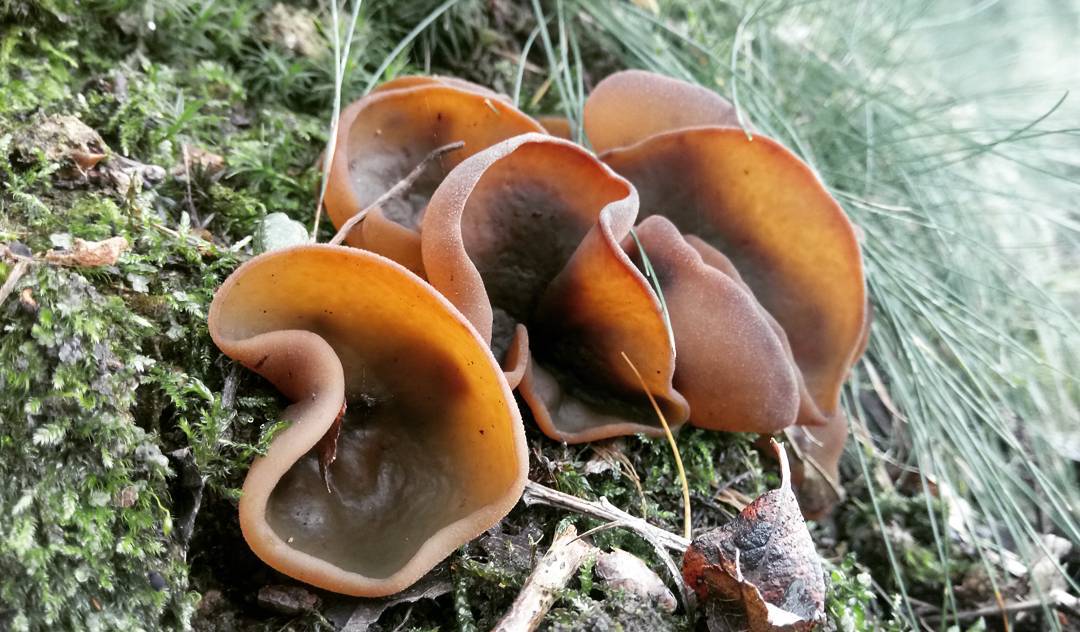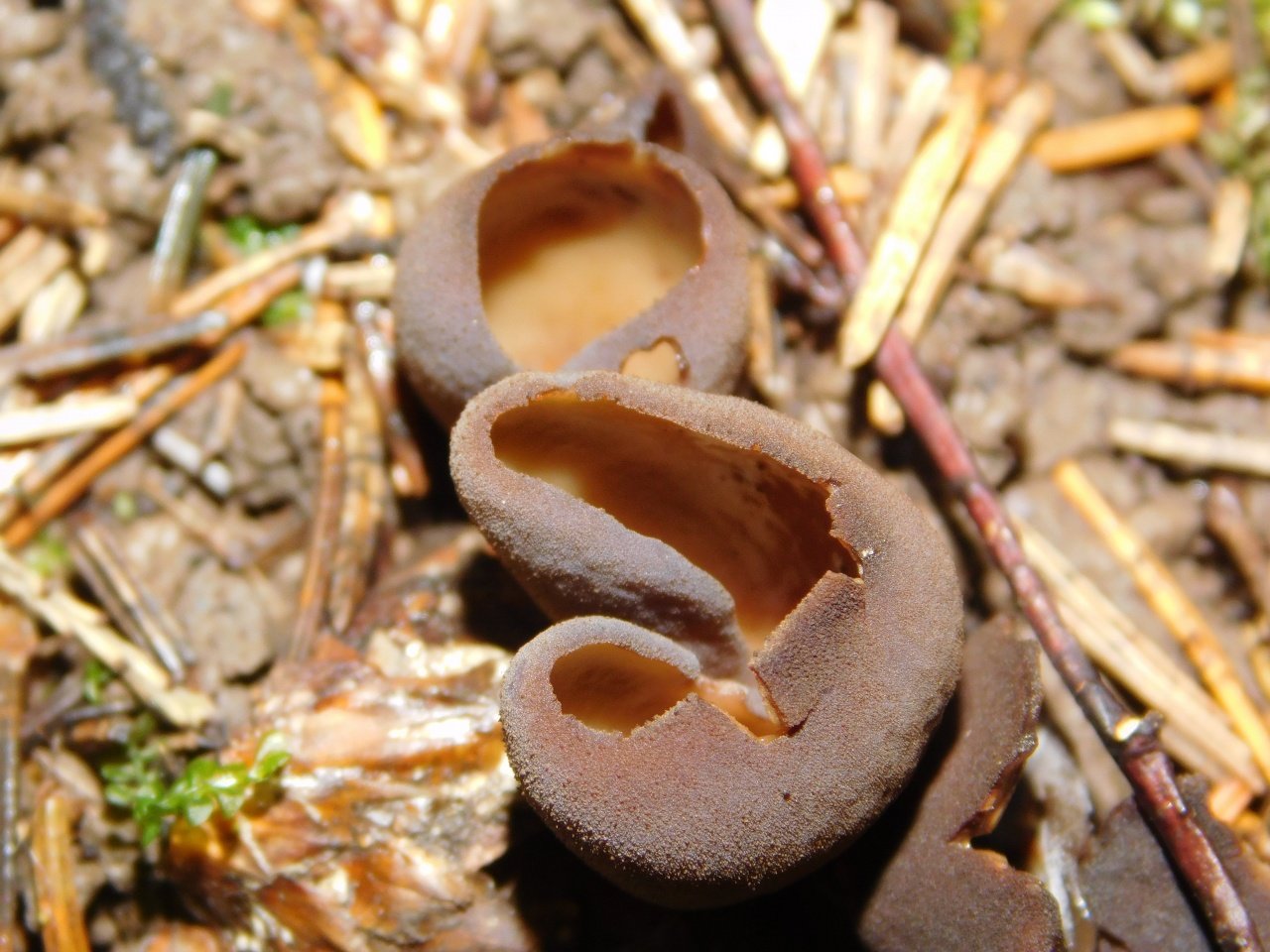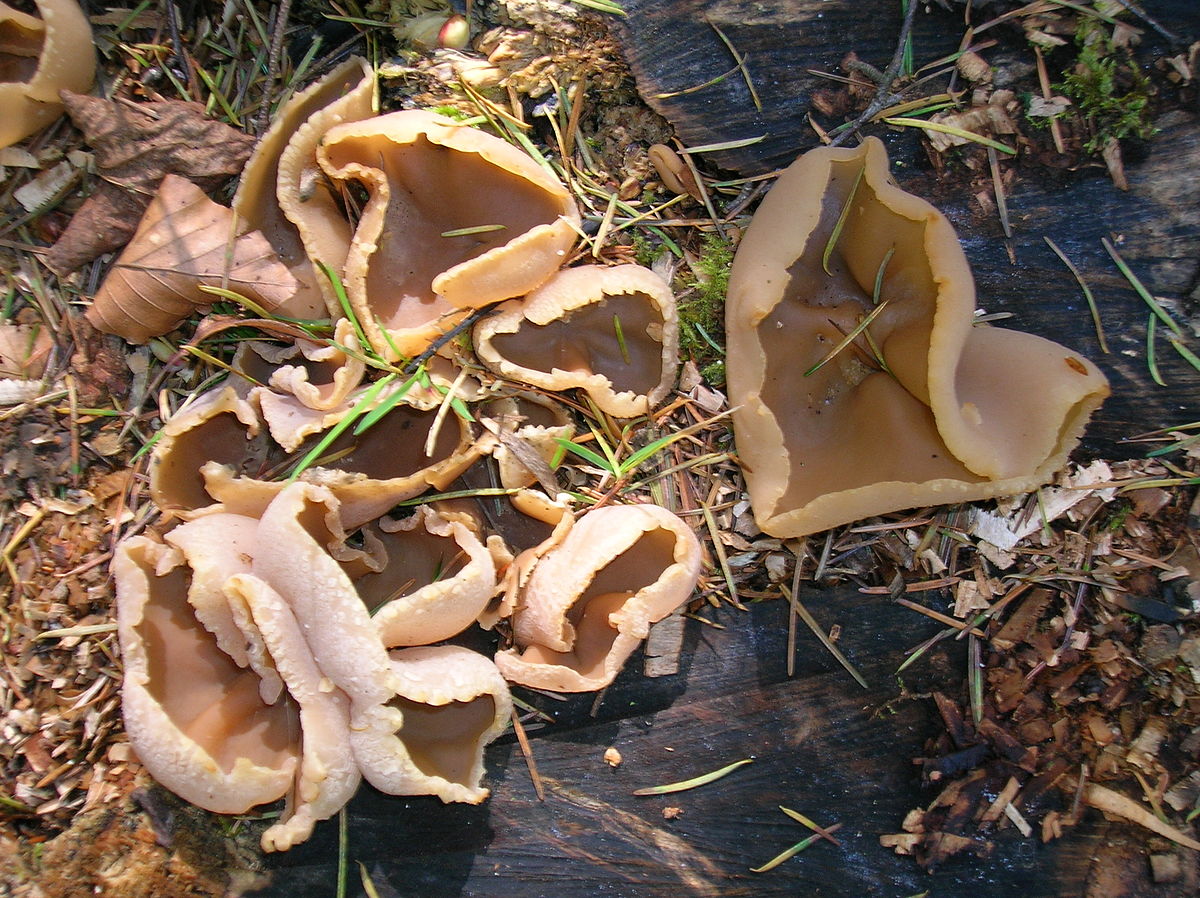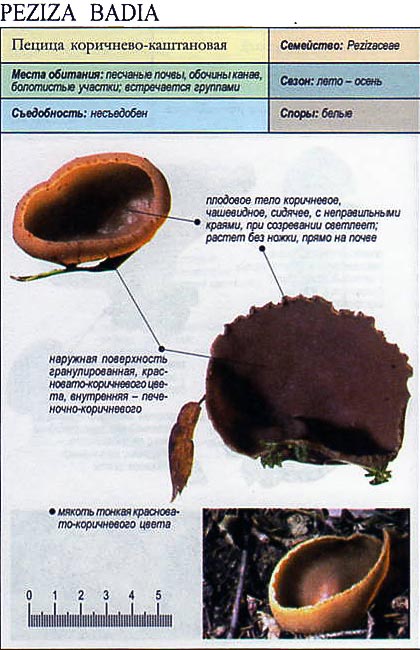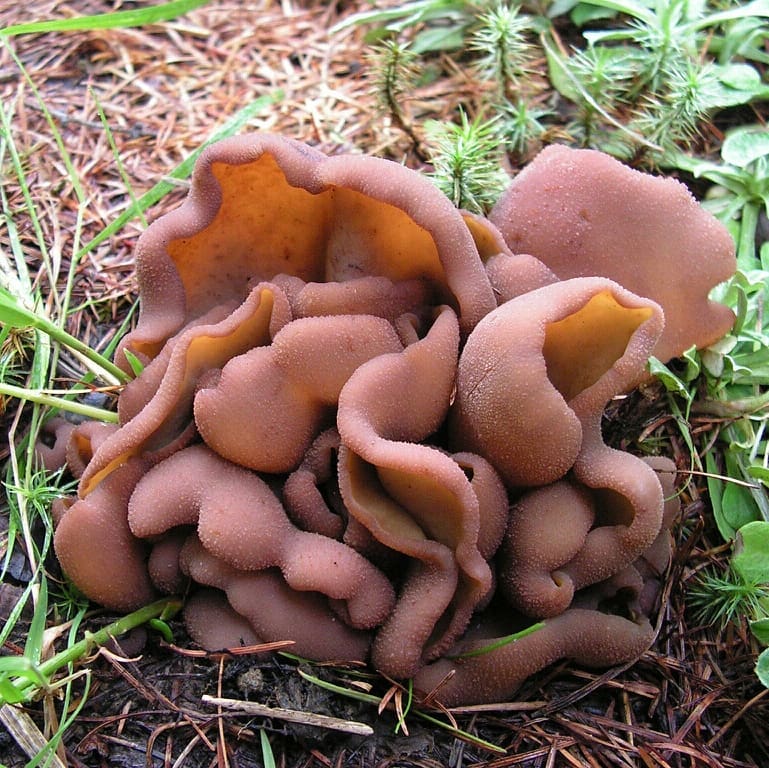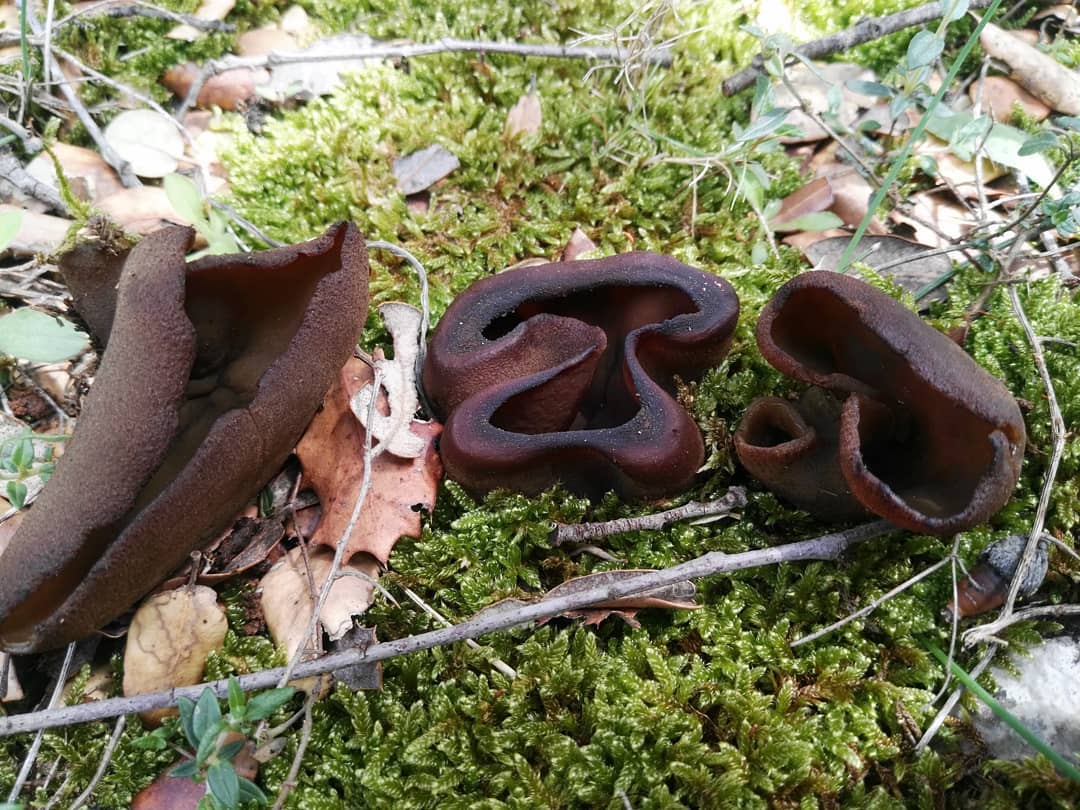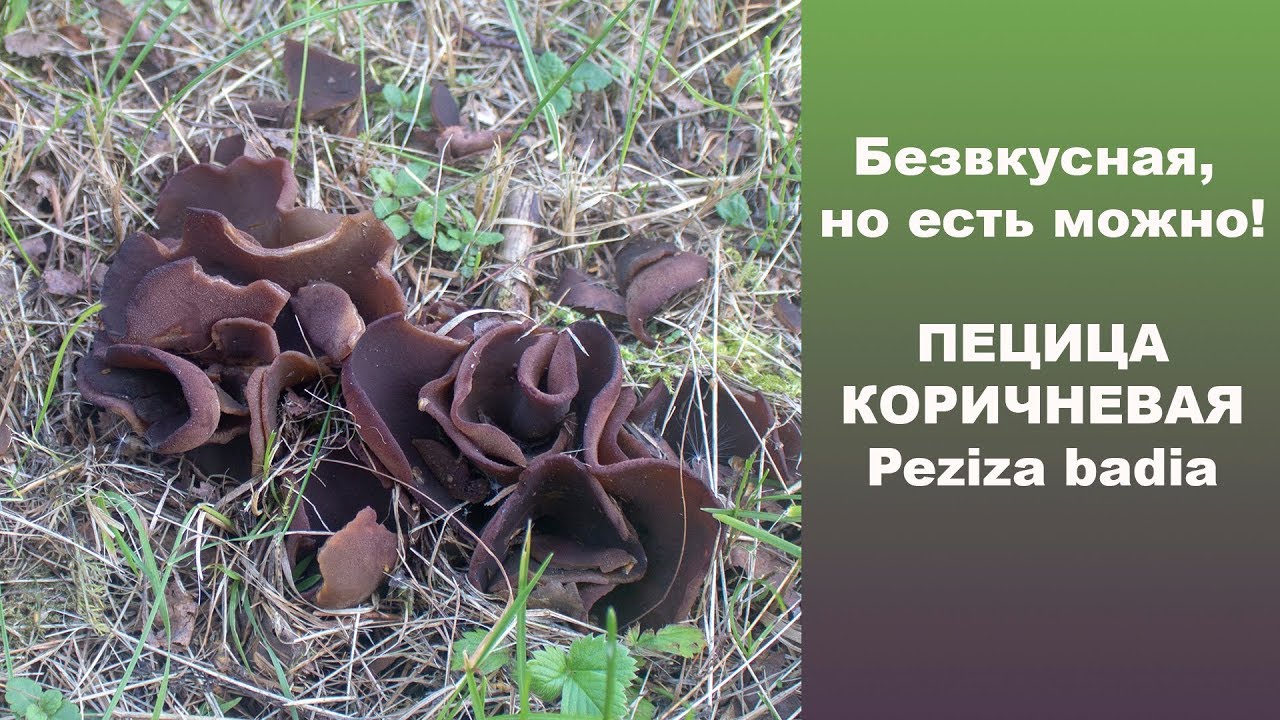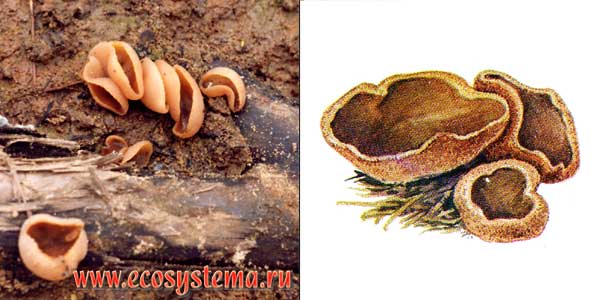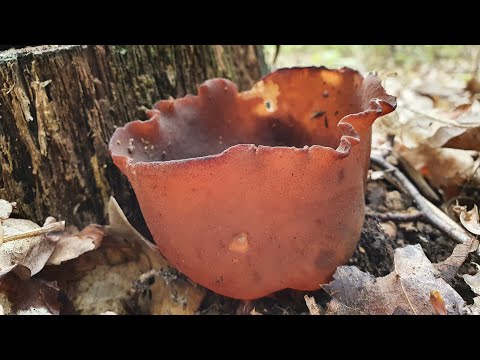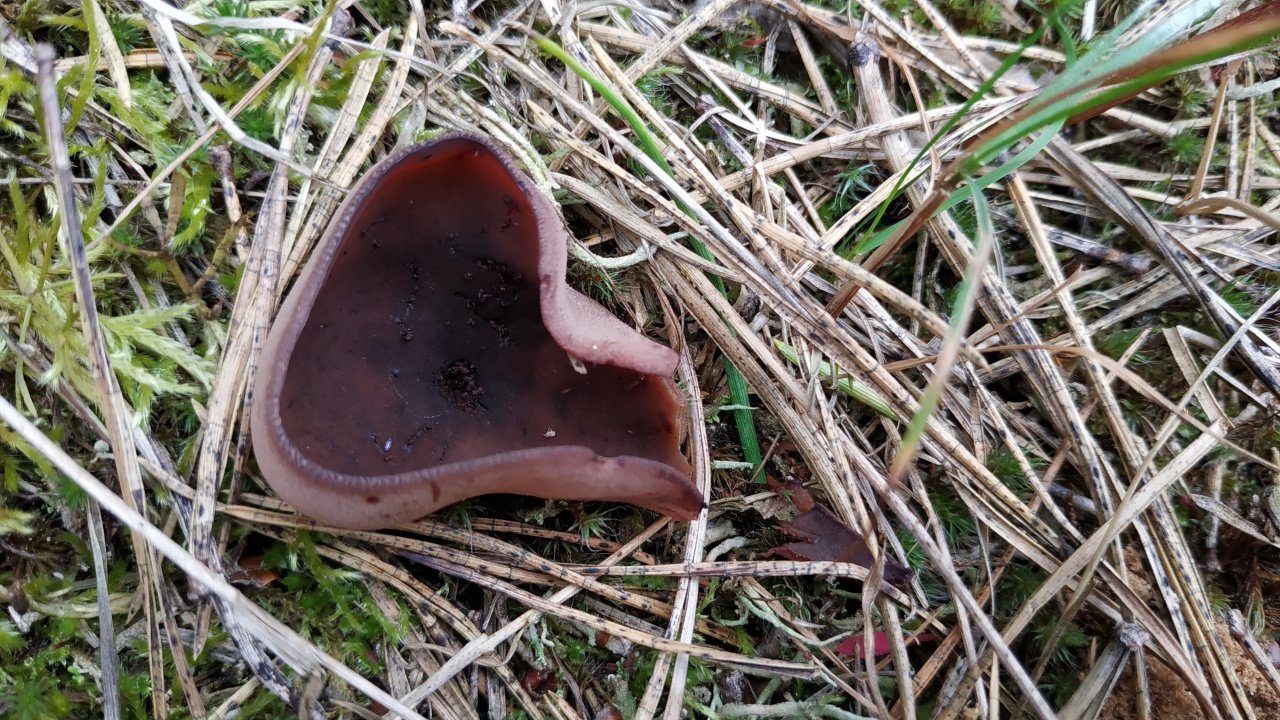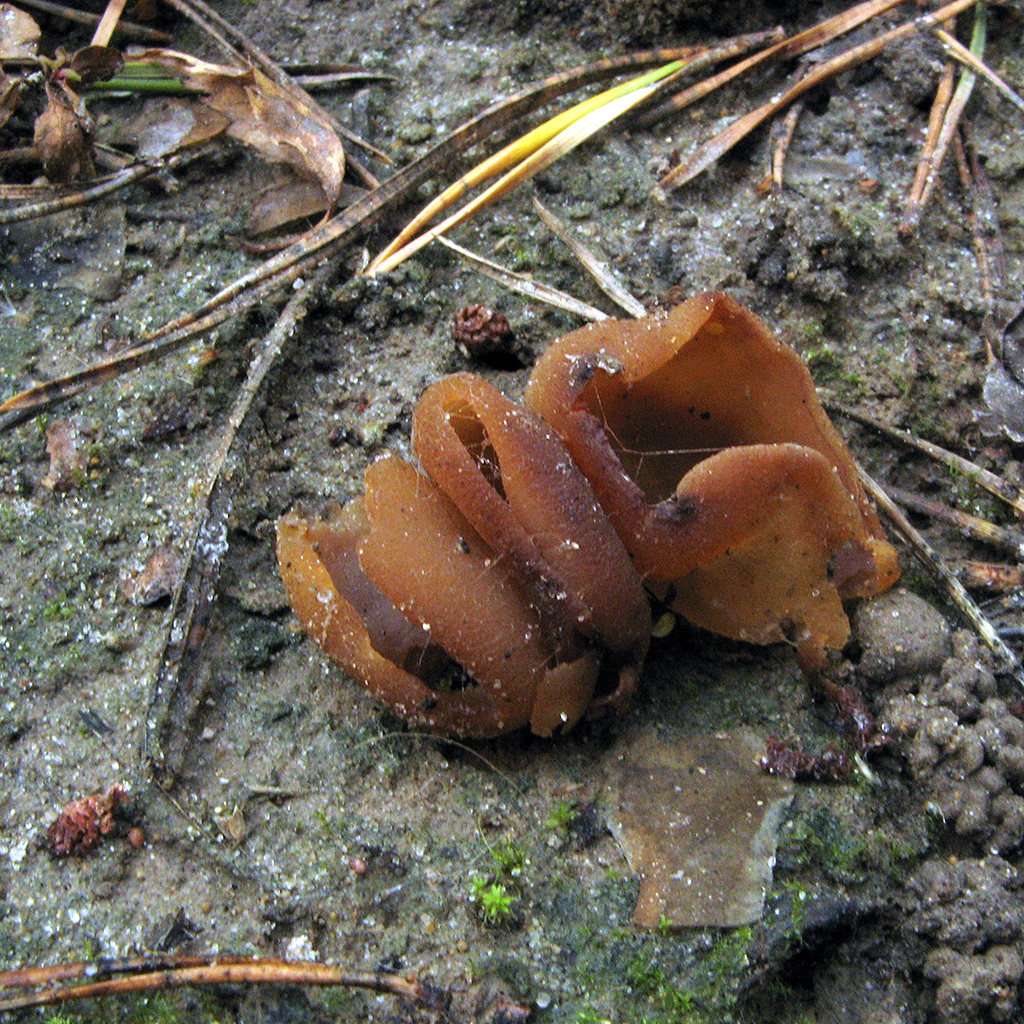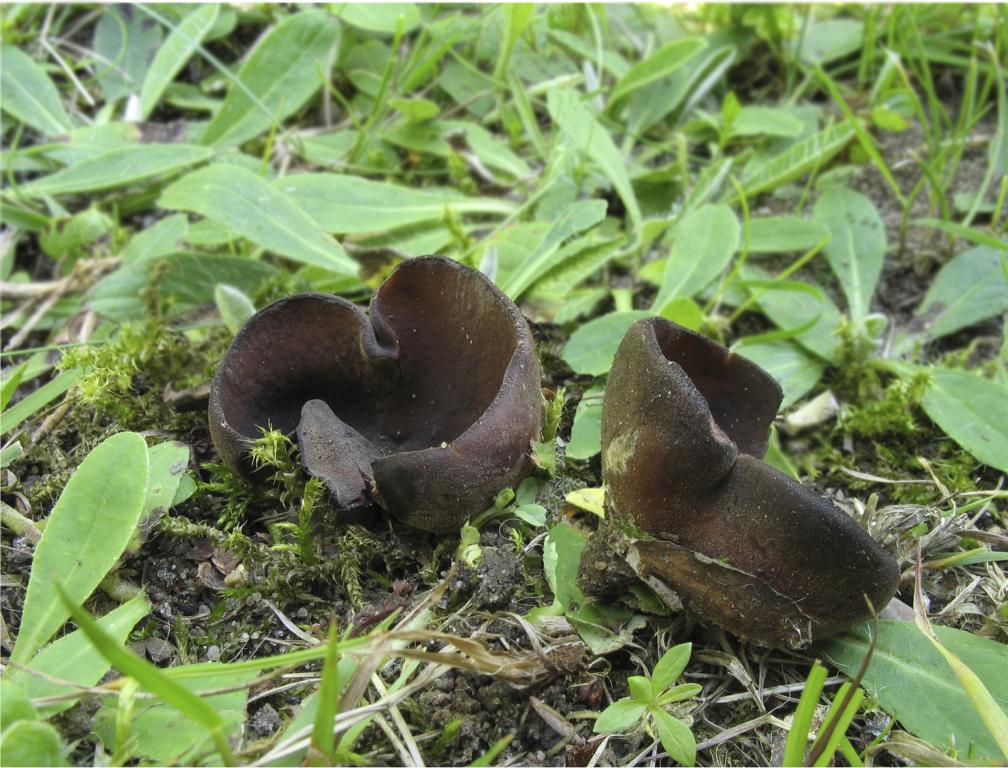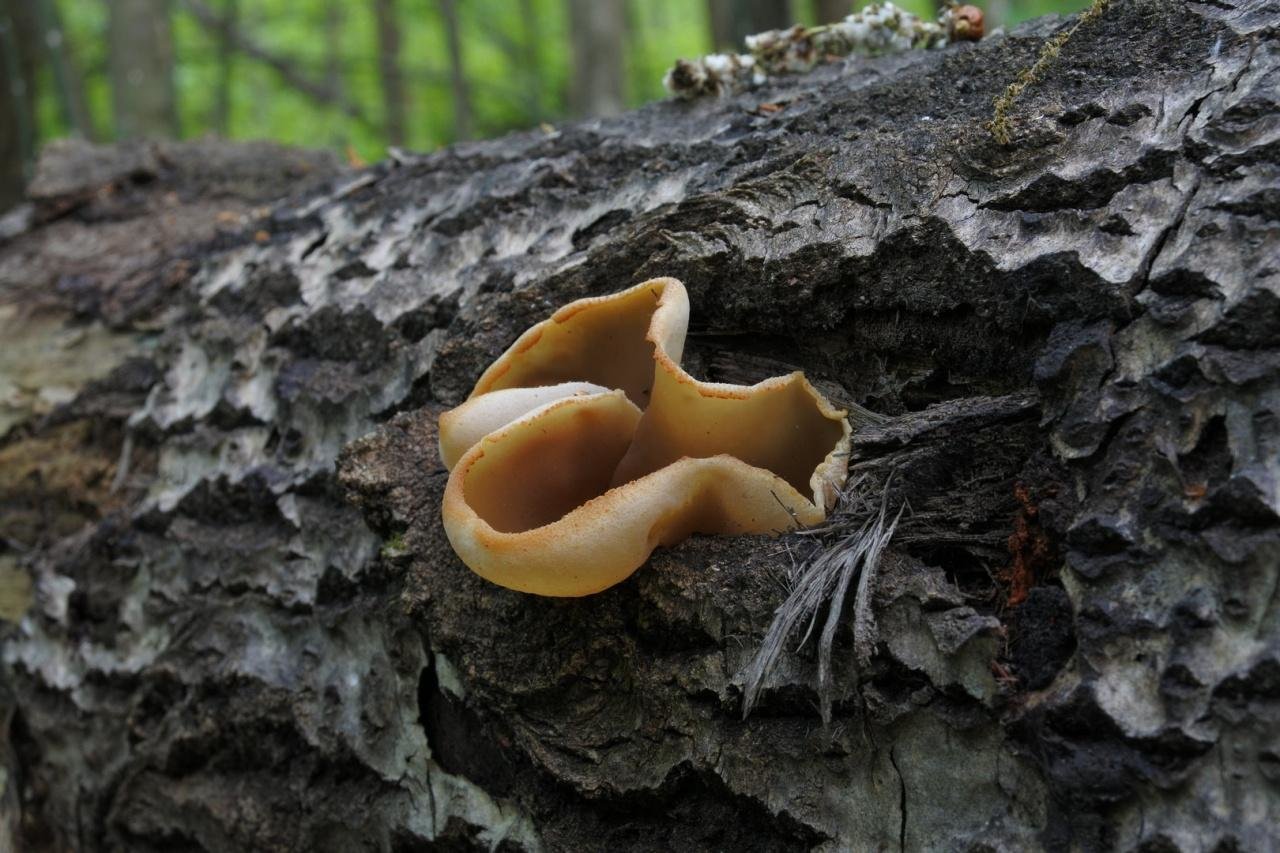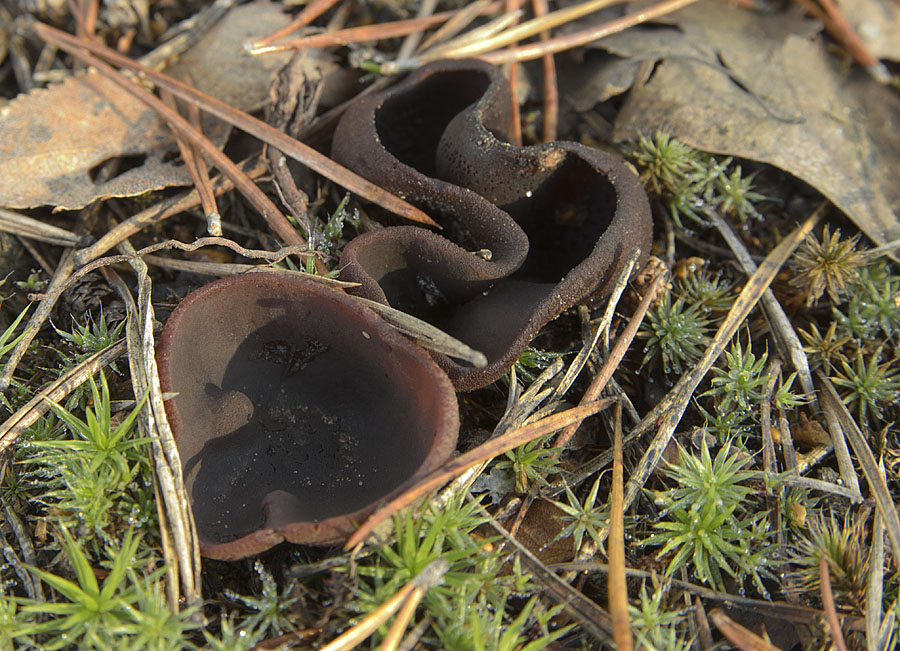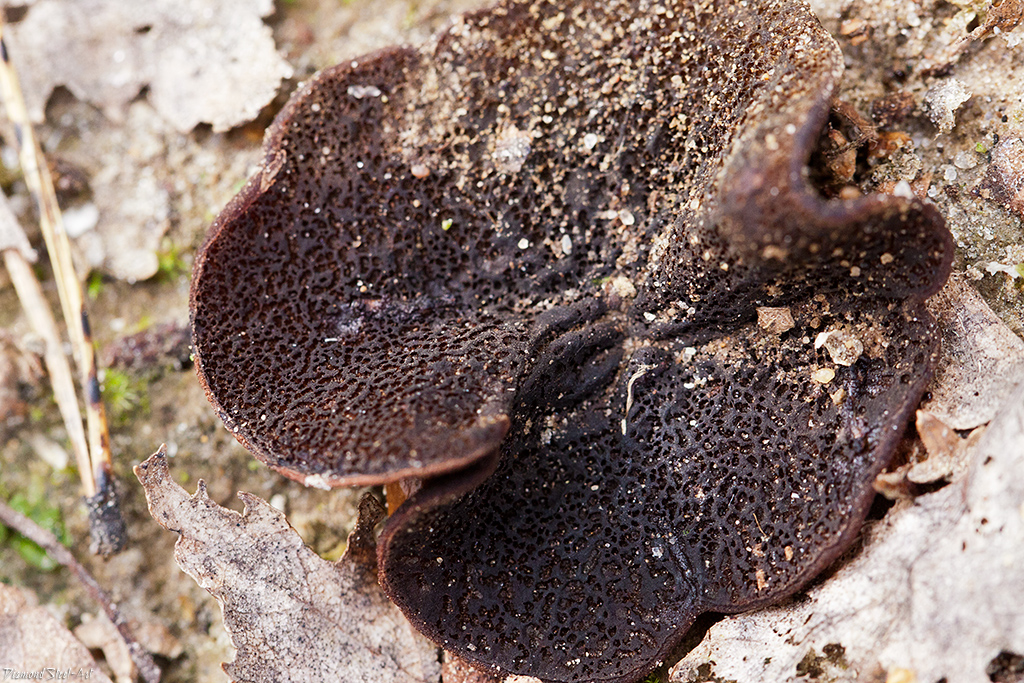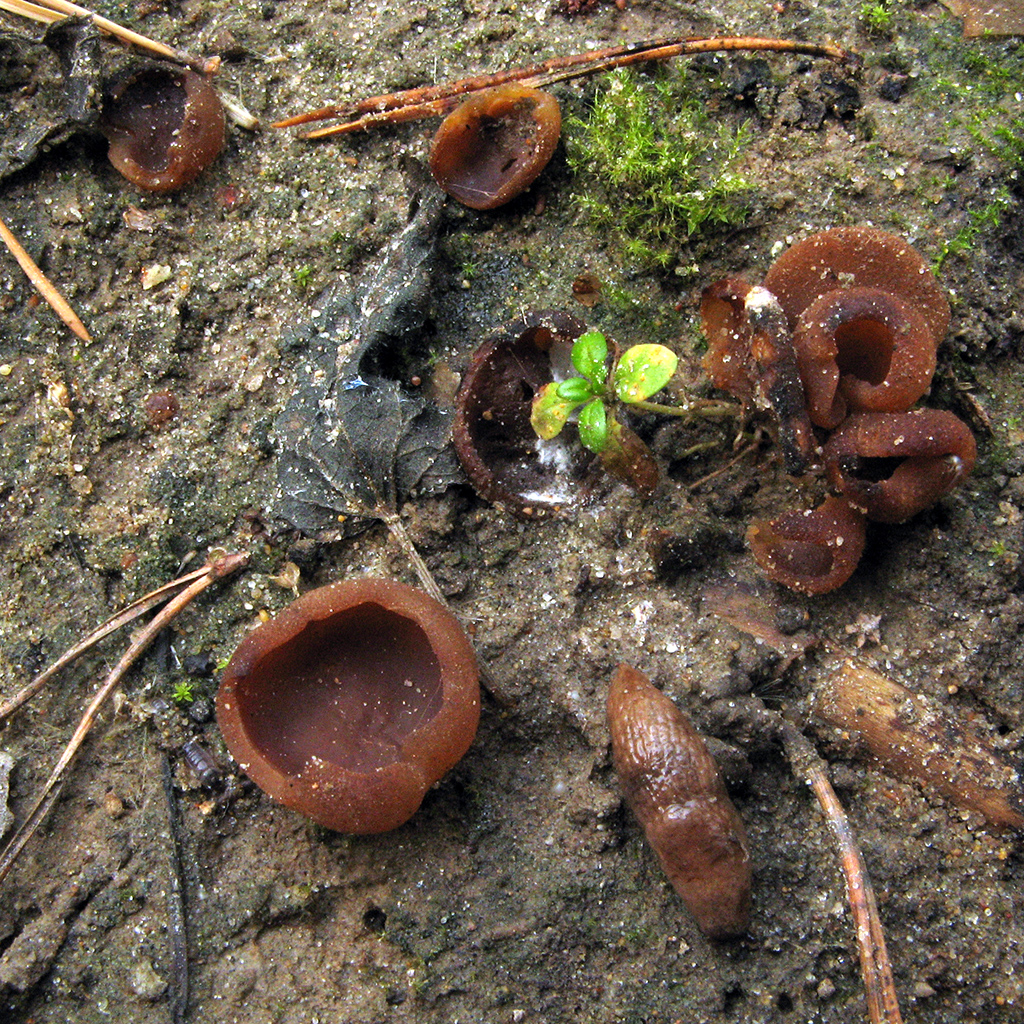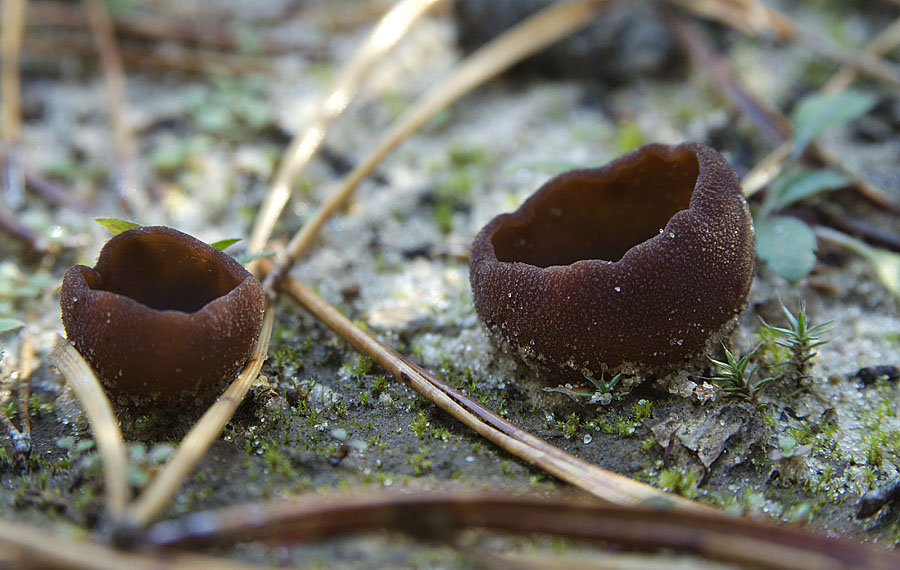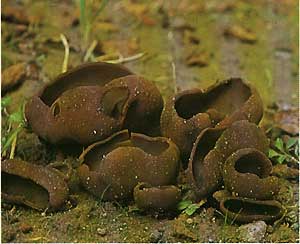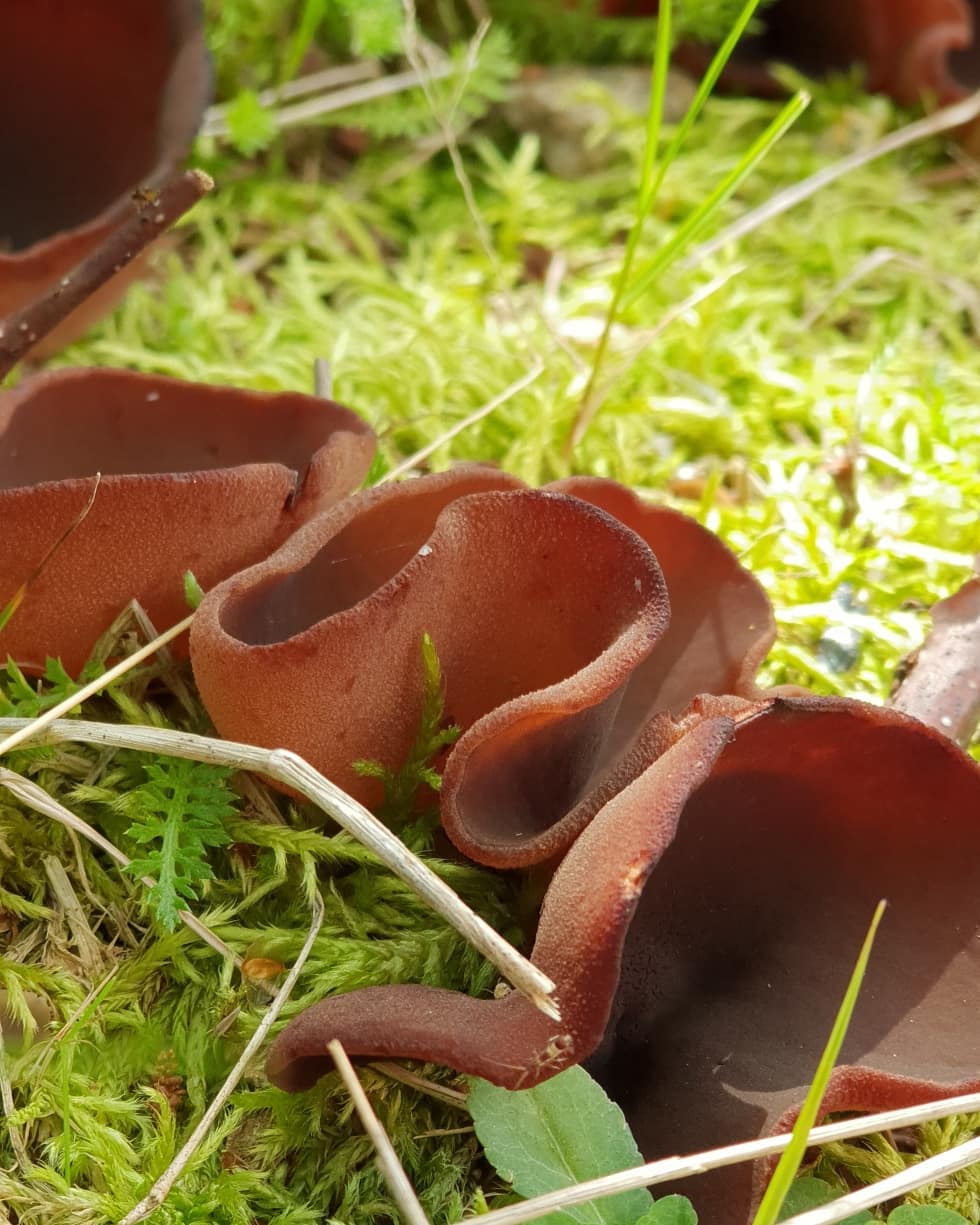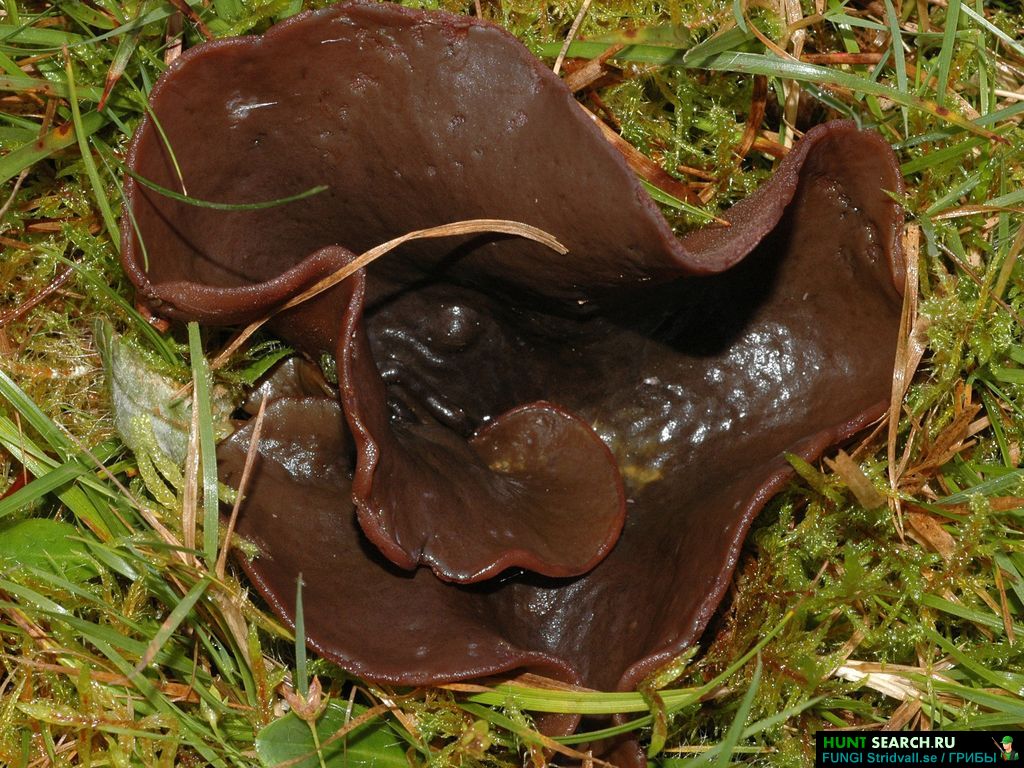Brown Pecica (Peziza badia)
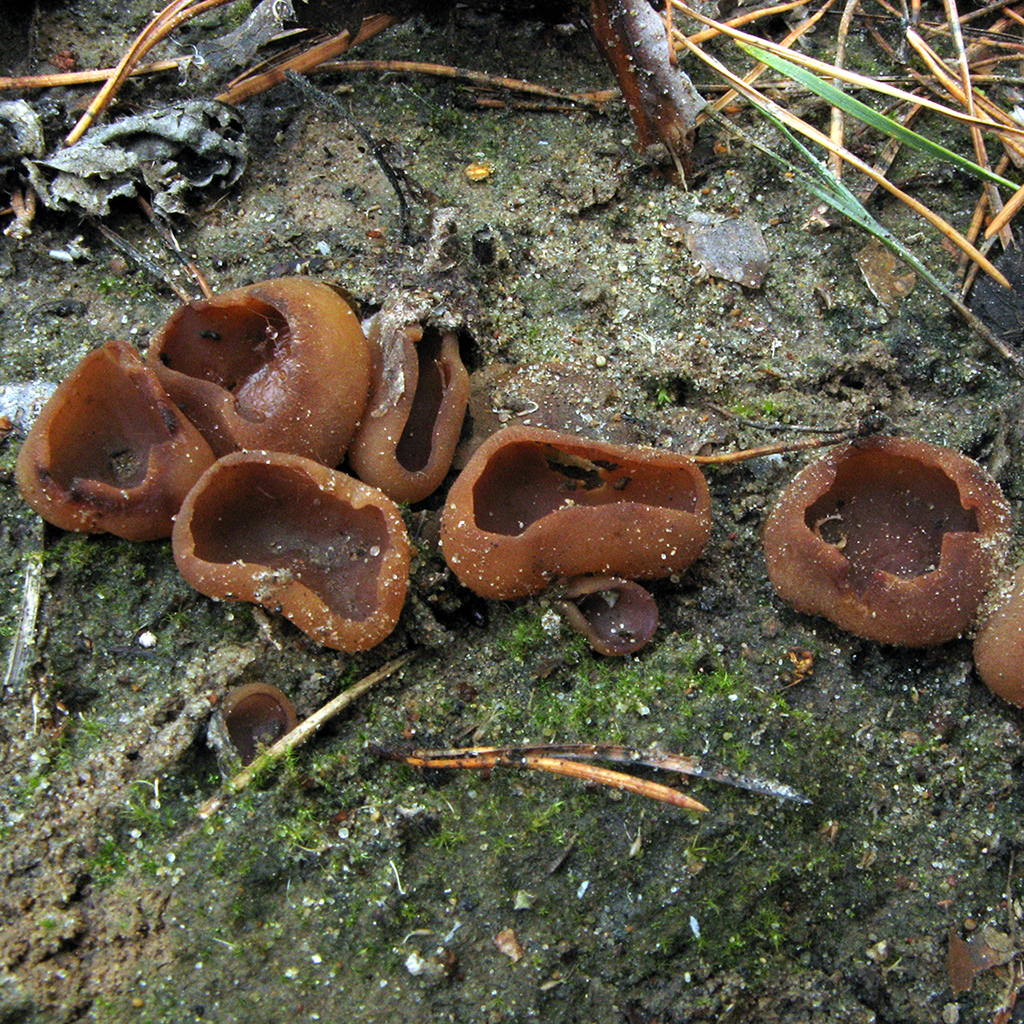
Current title
| Index Fungorum | Peziza badia Pers. | |
| MycoBank | Peziza badia Persoon |
Systematic position
Habit
Fruit body: Cup-shaped, saucer-shaped, in the form of ears (discomycetes)
Hymenophore: Smooth, not pronounced
Fruiting body
Apothecia in groups, with a dark brown or olive-greenish hymenial layer, chestnut brown on the outside, 1 - 6 cm in diameter, fleshy, at first almost spherical, later cupped or saucer-shaped, wavy-rounded, sometimes flattened oval, sessile.
Microscopy
Bags are cylindrical, 300 × 12 - 15 microns, eight-spore.
Spores are ellipsoidal, with a thick, slightly warty membrane, with one or two drops of oil, 15 - 20 × 8 - 11 μm, located in the upper part of the bursa in one row.
Paraphyses are branched, up to 3 µm wide, expanded at the apex up to 6 µm, slightly yellowish.
Iodine bags turn blue intensely.
Ecology and distribution
It is found in forests of various types, preferring wet places, settles both on the soil and on strongly rotted wood, on deadwood and stumps.
Fruiting
From mid-May to early autumn.
The divisions correspond to the decades of the month.
Nutritional properties
Poor quality mushroom, tasteless.
Related materials
Smitskaya M.F. - Operculative discomycetes (Flora of fungi of Ukraine) (1980)
Link to this page for prints
Ageev D.V., Bulonkova T.M. Brown-chestnut pecitsa (Peziza badia) - Mushrooms of Siberia URL: https://mycology.su/peziza-badia.html (date of access: 01/26/2020).
Share link
Discussions

| 242 | |
| Dmitry Ageev | |
| 2010-08-27T11: 43: 54 | |
| Last modified date: | 2018-11-15T11: 09: 34 (Dmitry Ageev) |
OOO OOO OOO OOO OOO OOO OOO OOO OOO OOO OOO OOO OOO OOO OOO OOO OOO OOO OOO OOO OOO OOO OOO OOO OOO OOO OOO OOO OOO OOO OOO OOO OOO OOO OOO OOO OOO OOO OOO OOO OOO OOO OOO OOO OOO OOO OOO OOO OOO OOO OOO OOO OOO OOO OOO OOO OOO OOO OOO OOO OOO OOO OOO OOO OOO OOO OOO OOO OOO OOO OOO OOO OOO OOO OOO OOO OOO OOO OOO OOO OOO OOO OOO OOO OOO OOO OOO OOO OOO OOO OOO OOO OOO OOO OOO OOO OOO OOO OOO OOO OOO OOO OOO OOO OOO OOO OOO OOO OOO OOO OOO OOO OOO OOO OOO OOO OOO OOO OOOì
Age restrictions
Federal Law of the Russian Federation of December 29, 2010 No. 436-FZ "On the Protection of Children from Information Harmful to Their Health and Development."
Control
2010–2019 All rights reserved.
Definitioner
Multicellular or unicellular non-spore-bearing outgrowths in some algae, fungi and mosses, which protect the genitals or spore-bearing organs from drying out and mechanical damage.
In the type, a completely open ascocarp, often saucer-shaped or goblet-shaped. On the surface of the apothecia there is an ordered hymenial layer, consisting of bags and sterile elements - the paraphysis, under it lies the subhymenal layer, in which the asci develop, and everything else is made up of sterile hyphae of the pulp - the excipule. Apothecia is characterized by the simultaneous maturation of many asci and the active release of spores. Secondary closed apothecia are found in fungi, whose fruiting bodies develop underground, for example, in truffles.
See Ascocarp, Hymenium, Discomycetes, Paraphysis.
A specialized cell of marsupial fungi (ascomycetes), inside which ascospores develop as a result of the sexual process.
The structure of the bursae is an important diagnostic feature used in the ascomycete system. There are prototunicate and eutunicate asci. The first ones have a thin shell, not divided into layers, which spreads out during the maturation of ascospores, and they are released passively. The latter have a denser, layered membrane, equipped with a specialized apical apparatus for opening, and ascospores are actively discarded.
Among eutunicate asci there are uniticate ones, the layers of the shell which grow together and open simultaneously, and bitunicate ones, whose shell consists of two sequentially opening layers. A further subdivision of uniticate bags is based on the structure of the apical apparatus.
Pecitsa varia (Peziza varia) how it looks, where and how it grows, edible or not
Pecitsa changeable: photo and description
Pecitsa varia (Peziza varia) is an interesting lamellar mushroom that belongs to the genus and family of Pecitsia. Belongs to the class of discomycetes, marsupials and is a relative of stitches and morels. Previously, it was distinguished by mycologists as a separate species. Recent studies at the molecular level have proven that the species considered to be separate species can be attributed to one large genus.
What does a changeable petsitsa look like?
Fruit bodies are bowl-shaped, do not have the usual caps. Young petsitsa changeable takes the form of a spherical cognac glass slightly open on top. As it grows, the edges straighten, taking on a funnel-shaped, and then a saucer shape with a pronounced depression in the place of growth and sides curled inward.
The edges are uneven, wavy, slightly ragged, jagged. There are chaotically spaced folds. The surface is smooth, brilliantly moist, like a varnish. The color is even, without differences, the color of coffee with milk, slightly greenish or brown shades. It can be creamy and golden-red. The outer surface is dull, with tiny hairs or scales, light, white-gray or yellowish. It can grow up to 15 cm. Its usual size is 4-8 cm.
The leg is missing. Some specimens have a small pseudopod. Spore powder is pure white. The pulp is gray or brown in color, with five to seven distinct layers.
Where and how it grows
The changeable pecitsa loves rotten, semi-rotten wood, saturated forest soil or old fires. The mycelium begins to bear fruit in the spring, when the weather is rather warm and the snow melts, it even got the name of the snowdrop mushroom. They continue to grow until the October frosts, and in the southern regions up to persistent frosts.
It occurs quite often, in small closely planted groups, in forests, gardens and parks. Distributed in the Krasnodar Territory and throughout Russia. It can also be seen throughout Europe and North America.
Is the mushroom edible or not
There are no exact data on the toxicity or edibility of this type of mushroom. The fruit body has an unsightly appearance, a thin rubbery flesh that is tasteless and devoid of any odor. The culinary value tends to zero, which is why the mushroom is considered inedible.
Doubles and their differences
Pecitsa changeable is extremely similar to the fruit bodies of the varieties of its own family. Their differences are minimal and almost invisible to the naked eye. Fortunately, no poisonous counterparts were found in the fungus.
Pecica ampliata (widened). Inedible. Does not contain toxic substances. As it grows, it acquires a pie-shaped, diagonally elongated shape and, as if smoked, brown-black edges. The color of the outer side is brownish-sandy.
Pecitsa Arvernensis (Auverne). Non-toxic, inedible due to low nutritional value. Has a darker color of the surface and pulp, the edges are smoother. You can often see a rudimentary pseudopod. The pulp is brittle, without pronounced layers.
Pecitsa repanda (blossoming). It is classified as an inedible mushroom due to its thin, tasteless pulp. The edges of the bowl are not wrapped, more elongated, for which they received the nickname "donkey ears".
Pecica micropus (small-legged). Inedible due to low nutritional value. The pulp is brittle, slightly layered. Its main difference from the changeable petsitsa is a pronounced pseudopod and small size, 1.5-6 cm in diameter.
Pecica Badia (brown). Non-poisonous, inedible. Fruit bodies have a rich brown and dark chocolate color, grow up to 16-18 cm.
Pecitsa changeable also bears great similarity to the fruit bodies of the genus Tarzetta (barrel-shaped, bowl-shaped, and others). They are distinguished by a pronounced pseudopod, light coloration of the outer side and miniature size, from 10 to 30 mm. Inedible due to their small size and low nutritional value.
Conclusion
Pecitsa changeable grows in forests on fallen trees and old stumps. It is found in gardens, parks and fields, on semi-rotted sawdust, in dead woods. Feels great on soil rich in woody humus. Has an original bowl shape. Its entire inner surface is a spore-bearing layer, the outer is sterile. The fungus can be found throughout the Northern Hemisphere in small groups from May to October.It has no nutritional value due to its thin, tasteless pulp, there is no exact data on the toxins or poisons it contains.
Description
Pecitsa is the scientific name for mushrooms. The people call them differently. There are mushrooms that appear in our spring forests - these are famous lines and morels, and besides them, amazing orange mushrooms appear along forest paths and on the edges, and just in the moss. Bright little mushrooms are very similar to bowls, and with age they become flatter, like ordinary saucers or plates, which gave them the name saucers.
These mushrooms are related to stitches and morels, and although they mainly grow on the ground, they quite often, like stitches, grow on the places of former fires and even cover the places of fires with their colonies. And the bubbly petsica very often chooses gardens and greenhouses as its habitat. These mushrooms have a very varied color. Brown pecs growing in the moist soil of forests are inedible mushrooms. But the orange pepper, the most attractive, looks like orange slices, which very often attracts mushroom pickers.
Beneficial features
These bright, beautiful mushrooms perfectly help the body, weakened after winter, to strengthen the immune system and recover from the season of colds and other seasonal diseases. One of the amazing properties of pecitsa is the ability not only to help with various eye diseases, especially with developing age-related hyperopia, but also to affect weak eye muscles and accelerate metabolic processes.
Due to its high content of vitamin C, which increases the body's resistance, mushrooms should be consumed during outbreaks of viral diseases. In addition, pecitsa can be used for various inflammations and even remove harmful toxins from the body of cancer patients who have undergone chemotherapy and residents of large cities suffering from environmental pollution.
Cooking use
Pecitsa is considered an edible mushroom, and differs from most mushrooms in the complete absence of any taste and almost complete absence of smell. They can be boiled and fried, added to salads and stews, but with this method of cooking, the mushrooms lose their amazing color. Salted petsitsa looks very beautiful, giving brightness to the mushroom assortment, and pickled mushrooms completely retain their color. Quite often, culinary experts use petsitsa to decorate various dishes, especially salads, they look very beautiful, aesthetically enrich dishes, turning them into culinary masterpieces. Dried mushrooms are made into a powder and added to sauces and seasonings to give them an orange color.
Pecica benefits and treatment
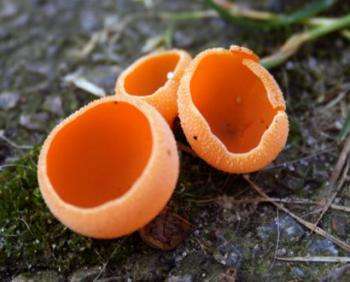
Pecitsa promotes blood thinning, it is especially valuable for patients with thrombophlebitis and varicose veins. For those who suffer from seasickness and cannot be in transport for a long time due to motion sickness, you can try taking a tincture of pecica.
Harm and contraindications
It is harmful if, instead of an edible orange, a brown pepper, considered inedible, falls into the mushroom picker's basket, and then there is a high risk of poisoning. In addition, mushrooms absorb harmful substances from the environment and should not be collected from roads.
Description of petsitsa changeable
The shape of young fruiting bodies resembles a hemisphere or bowl. Over time, the correctness of the shape is lost, the fruiting body straightens and becomes like a saucer. The edges of the mushroom are often uneven, torn. This mushroom is called "mutable" for its irregular shape, it is impossible to find two identical fruiting bodies. The inner surface of the mushroom is smooth, brown in color, and the outer surface is grainy, with a matte bloom. The outside of the mushroom is lighter than the inside. Its diameter is 2-6 centimeters. The color of the fungus can vary greatly from gray-brown to brown.

The pedicle is most often absent, but sometimes a rudimentary pedicle is present. The pulp is very thin and brittle. The color of the pulp is white.It does not stand out with a special taste and smell. In the cut of the pulp, you can see at least 5 layers under a magnifying glass. The spores are transparent, oval in shape. Spore white powder.
Spread of petsica volatile
Pecitsa changeable grows on strongly rotted wood, it can also settle on the soil, but the soil must be saturated with wood waste. In addition, Pecitsa changeable grows in places of fires.
These mushrooms are quite common, but they grow in small numbers. Fruiting petsitsa changeable from January to February, which is usually not typical for mushrooms.

Evaluation of the palatability of Pecica volatile
There is no information about the toxicity of these mushrooms, but their nutritional value is low, therefore they are classified as inedible species.
The similarity of petsitsa changeable with other mushrooms
In the genus Pecitsa there are several representatives similar to the Pecitsa varietal, and it is almost impossible to distinguish them in the field. Ragged edges and irregular shape are a characteristic feature of the petsitsa changeable.

Other mushrooms of this genus
Orange pecitsa is a conditionally edible mushroom. The diameter of its fruiting body can be up to 10 centimeters. Its shape changes from spherical to saucer-shaped. The edges of the mushroom are wavy. The color is bright orange, lighter on the outside. The pulp is thin, orange, odorless and tasteless.
These mushrooms grow in coniferous and deciduous forests. They settle on damp sandy soil, choosing well-lit places. Mostly found in large groups. Orange pecica bears fruit from August to September.
Bubble pecica is a conditionally edible mushroom. Young mushrooms have bubble-shaped fruiting bodies; in old age, the shape is similar to a bowl with torn edges. The diameter of the fruiting body of the bubbly pezzitsa is 5-15 centimeters. The surface of the mushroom is sticky. It is brown on the inside and lighter on the outside. The pulp is brittle, fibrous, tough, odorless and tasteless.

Platypica bears fruit from May to October. These mushrooms settle in forests of various types and in gardens. Found under birches and aspens. Choose wet places. They grow singly or in groups, when several mushrooms grow together, their fruiting bodies are often deformed
Family Sarcoscyphae - Sarcoscyphaceae
Sarcoscifa bright red (petsitsa bright red)
Sarcosypha coccinea (Jacq.) Ske.
Xylotroph
Fruiting body up to 6 cm in diameter, cupped, bright red, whitish outside (sterile side). There is a short small leg. Pulp rather thick, fragile, waxy, without any particular odor. Meets in early spring, mainly during snowmelt alone and in small groups on reliable branches submerged in the soil. Sarkoscifa red is not only very beautiful, but also edible mushroom. At a time when the trees are not yet covered with foliage, they adorn the spring forest, are clearly visible from afar. Sarcoscifa can be called a flower mushroom, a mushroom of aesthetic pleasure, in this regard, it is necessary to protect and spare them. Comes across a bright red saucer very rarely, when they meet, they should admire, photograph, but not touch, let them stay in the forest.
